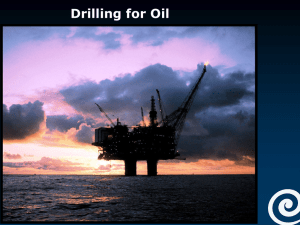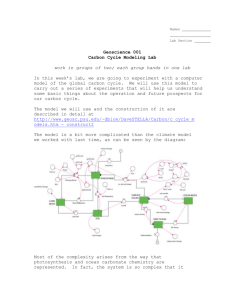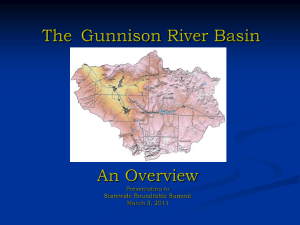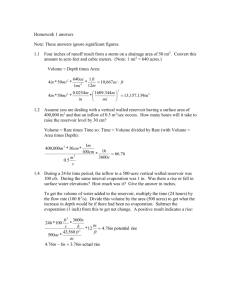grl53977-sup-0001-AA
advertisement
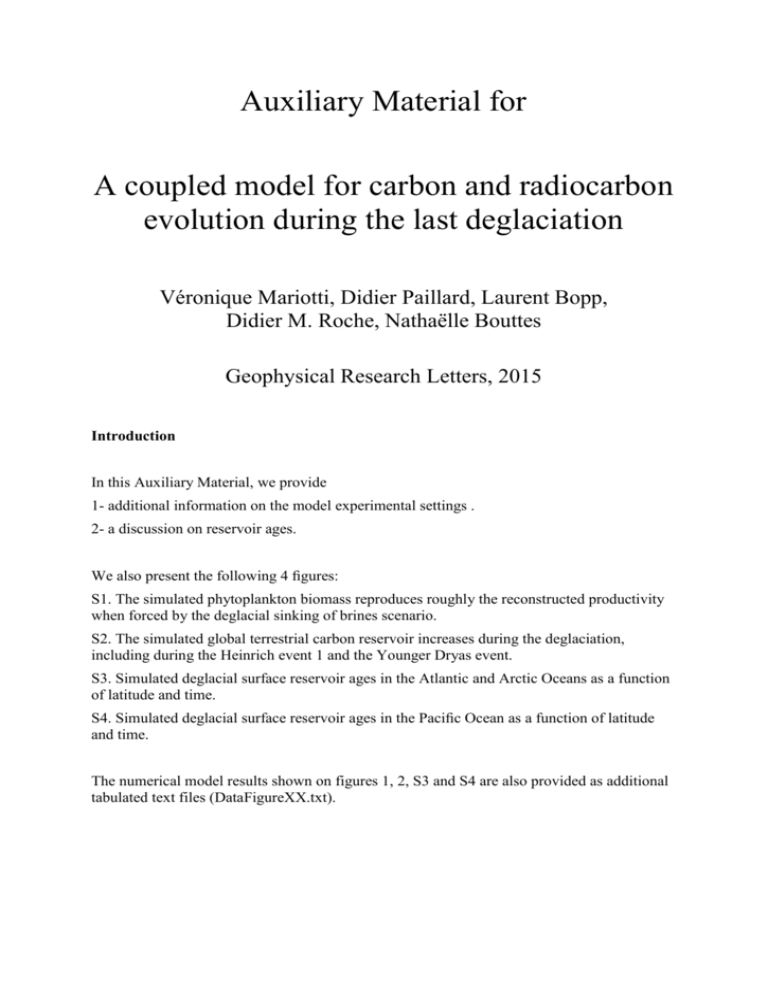
Auxiliary Material for
A coupled model for carbon and radiocarbon
evolution during the last deglaciation
Véronique Mariotti, Didier Paillard, Laurent Bopp,
Didier M. Roche, Nathaëlle Bouttes
Geophysical Research Letters, 2015
Introduction
In this Auxiliary Material, we provide
1- additional information on the model experimental settings .
2- a discussion on reservoir ages.
We also present the following 4 figures:
S1. The simulated phytoplankton biomass reproduces roughly the reconstructed productivity
when forced by the deglacial sinking of brines scenario.
S2. The simulated global terrestrial carbon reservoir increases during the deglaciation,
including during the Heinrich event 1 and the Younger Dryas event.
S3. Simulated deglacial surface reservoir ages in the Atlantic and Arctic Oceans as a function
of latitude and time.
S4. Simulated deglacial surface reservoir ages in the Pacific Ocean as a function of latitude
and time.
The numerical model results shown on figures 1, 2, S3 and S4 are also provided as additional
tabulated text files (DataFigureXX.txt).
1 - Model experimental setting
The CLIMBER-2 model [Petoukhov et al., 2000; Ganopolski and Rahmstorf, 2001] has
been used for numerous paleoclimatic experiments and has been tested under a variety of
different climatic situations. The simulated climate compares favorably with other EMIC
models, with more sophisticated AOGCM models and historical observations [see eg. Eby et
al, 2013]. The version used here is CLIMBER-2.4 with the carbon cycle component of
[Brovkin et al., 2007]. But in contrast to [Brovkin et al., 2007], we are using brine-sinking as
the main mechanism for glacial pCO2 lowering, as explained in more details in Bouttes et al.
[2010; 2011; 2012a; 2012b]. The atmospheric 14C model component is described in Mariotti
et al. [2013].
The experimental setting used here is very similar to the one used in these previous
simulations, but we are using a more restricted set of forcing parameters. We therefore want
to highlight here the slight differences in model parameters:
1 - Iron fertilization.
In these previous simulations, we investigated the role of iron fertilization on pCO 2 [eg.
Bouttes et al., 2012] and glacial 14C [Mariotti et al., 2013] with the conclusion that this was
not a major forcing of the carbon cycle in our experiments, with a pCO2 response smaller than
5 ppm and ∆14Catm response of about 1‰ [Mariotti et al., 2013]. Therefore, for simplicity,
there is no iron fertilization in the simulations presented here.
2 - Brine-sinking parameter "frac".
This is clearly our major forcing, as explained in the main text. The starting value used here
for LGM is frac = 0.7 (see Figure 1b). In Mariotti et al .[2013], we investigated a range
between 0.6 and 0.8 for the equilibrium LGM carbon cycle, while in the transient experiment
of Bouttes et al. [2012], the "frac" parameter was set to 0.6 during the LGM. These slight
changes have no significant impact on the behaviour of the model, and correspond to a
slightly different balance of forcing parameters and scenarios (equilibrium or transient, iron
fertilization or not, slightly different "frac" and "" values as discussed here). The scenario
used here (Figure 1b) is of course an idealization of a much more complex reality: there is no
reason to believe that "frac" should be a fixed number that could be "tuned" to some
observations, since it corresponds to the dynamic behaviour of ice-shelves / ice-sheet
geometry and its impact on the formation of gravity currents on the topography in different
areas around Antarctica. There are strong indications that it should be variable, even during
the Holocene (eg. Harris et al, 2000).
3 - Vertical diffusion parameter .
In the original CLIMBER 2.4 ocean model, the vertical diffusivity z is constant, while in
more sophisticated model, it depends on vertical stratification. Indeed, for a given amount of
mechanical energy, mixing is easier when stratification is lower. Unfortunately, the energetics
of turbulent deep ocean mixing is still currently not well understood (ie. dissipation of internal
waves on bottom topography) and many physical parameterizations have been suggested. In
order to represent the effect of salty bottom waters on deep ocean mixing, it is critical to
account for this direct consequence of stratification on ocean physics. This is why in Bouttes
et al [2011] and subsequent publications, we used the Marzeion et al., [2007]
parameterization, where the vertical diffusivity is given by:
𝑁 −𝛼
𝜅𝑍 = 𝜅0 ( )
𝑁0
where N is the buoyancy frequency. The critical parameter is the exponent . In Bouttes et al.
[2011], values between 0 and 1 were experimented. With = 0 the brine-sinking mechanism
induces changes in the oceanic salt distribution and consequently in ocean circulation, but it
does not affect vertical mixing, while for > 0 the brine-sinking mechanism also modifies
vertical mixing. This parameter therefore amplifies the effect of our brine-sinking mechanism.
In Mariotti et al. [2013], was chosen between 0.5 and 0.8, while in the present study it is
fixed to = 0.6. In the real world, it is clear that > 0, but there is no consensus on a specific
numerical value.
In these different previous publications, we investigated the sensitivity of our model against
the numerical values of these parameters, while in the present study we focus the discussion
on 14C and its time evolution throughout the deglaciation.
2 - Reservoir ages
We are using a fully coupled climate-carbon model. This allows us to obtain additional
results. Indeed, the simulation performed provides reservoir ages that are varying in location
and time, as a result of ocean dynamical changes. Indeed, such ocean circulation-induced
changes in reservoir ages are difficult to infer from data reconstructions and our model may
provide a useful discussion framework. Some modeling results have already been proposed
using ocean-only general circulation models (eg. Butzin et al, 2012), but not with a fully
coupled climate-carbon model like in our experiments. Such model-output information could
be used in marine ∆14C reconstructions to reduce the uncertainty on surface reservoir ages and
therefore provide more accurate 14C dating.
As shown on Figure S3, in the surface western Atlantic Ocean the simulated reservoir age
reaches values up to 1,900 years in certain regions and time periods, which is much older than
the 350-to-450-year reservoir age used by default in paleoceanographic reconstructions, due
to the lack of constraint except in some studies. The deglacial decrease in the reservoir age of
the Southern Ocean (south of 60°S) is coherent with the outgassing of the abyssal 14Cdepleted carbon reservoir. This deep reservoir gets younger by mixing with the water masses
above. The old reservoir ages (~ 800 - 1,600 years) in the North Atlantic (north of 50°N)
between 18 and 15 ka BP are due to an increase of stratification and sea-ice extent in response
to the freshening scenario. This freshwater and sea-ice lid isolates the surface water masses
from the atmosphere, inducing an increase of the reservoir age. This is supported by previous
studies based on foraminifera data [Waelbroeck et al., 2001]. Related to this North Atlantic
old reservoir age region are two other areas: the local minimum reservoir ages in the tropical
Atlantic Ocean between 17.5 and 15.5 ka BP and the local minimum reservoir ages in the
Southern Ocean around 15 ka BP. Both these patterns result from the deep advection of the
North Atlantic negative anomaly. It is also interesting to note that our results for the surface
Equatorial Pacific ocean (Figure S4) are qualitatively in agreement with the new data of de la
Fuente et al. [2015], both showing a significant decrease of reservoir ages during the Heinrich
statial 1.
Supporting Figure S1: The simulated phytoplankton biomass reproduces roughly the
reconstructed productivity when forced by the deglacial sinking of brines scenario. a,
Scenarios of sinking of brines; b, measured opal flux (in g.cm-2.ka−1) from TN057-13PC
[Anderson et al., 2009]; c, simulated phytoplankton biomass (in µmol.l−1) at the same location
than TN057-13PC. The dashed black lines correspond to a scenario of a changing deglacial
sinking of brines, while the dashed red lines correspond to a scenario of a fixed deglacial
sinking of brines. With a fixed sinking of brines scenario, the phytoplankton biomass does not
reproduce the deglacial variations of the productivity proxy. Note that the model for
productivity is limited to one nutrient (phosphate) with only four levels on the first 250 meters
of the ocean, so the simulated phytoplankton biomass (c, dashed-black line) cannot represent
closely the changes observed in opal fluxes (b). But at least, we see that the decreased sinking
of brines between 18 kaBP and 16.5 kaBP induces a 50% rise in the phytoplankton biomass.
This is due to the sudden increase in ventilation in the Southern Ocean in response to the
break down in the brine-induced stratification. More nutrients are then available in the
subsurface waters, which increases the productivity.
Supporting Figure S2: The simulated global terrestrial carbon reservoir increases during the
deglaciation, including during the Heinrich event 1 and the Younger Dryas event. The
simulated terrestrial carbon reservoir (in GtC, gigatons of carbon) in response to the deglacial
sinking of brines scenario presented in Fig.1 of the paper is represented as a function of time.
The terrestrial model does not include carbon from permafrost or carbon locked under
continental ice sheets that have been proposed as possible contributors for the deglacial pCO2
rise [Zech et al. 2011]. This might explain the mismatch between model and data during the
two phases of the pCO2 rise.
Supporting Figure S3. Simulated deglacial surface reservoir ages in the Atlantic and Arctic
Ocean vary in latitude and time, far from the usually hypothesized 350-to-450 years.
Simulated reservoir ages are computed as the average on the first 150 meters of the water
column. The same figure has been done for the Pacific Ocean (Figure S4).
Supporting Figure S4: Simulated deglacial surface reservoir ages in the Pacific Ocean vary
in latitude and time, far from the usually hypothesized 350-to-450 years. Simulated reservoir
ages are computed as the average on the first 150 meters of the water column. The horizontal
white thick line around 60°–70°N is due to the longitudinally averaged geometry of the
model: it represents Siberia and Alaska with a closed Bering Strait.
References
Anderson R, et al. (2009) Wind-driven upwelling in the Southern Ocean and the deglacial rise
in atmospheric CO2. Science 323:1443–1448.
Bouttes, N., D. Paillard, and D. Roche (2010), Impact of brine-induced stratification on the
glacial carbon cycle, Climate of the Past, 6(5), doi:10.5194/cp-6-575-2010.
Bouttes, N., D. Paillard, D. Roche, V. Brovkin, and L. Bopp (2011), Last glacial maximum
CO2 and 13C successfully reconciled, Geophysical Research Letters, 38(2), L02,705,
doi: 10.1029/2010GL044499.
Bouttes, N, Paillard, D, Roche, DM, Waelbroeck, C, Kageyama, M, Lourantou, A, Michel, E,
Bopp, L, Impact of oceanic processes on the carbon cycle during the last termination.
Clim Past (2012a) vol. 8 (1) pp. 149-170.
Bouttes, N, Paillard, D, Roche, DM, Systematic study of the impact of fresh water fluxes on
the glacial carbon cycle. Clim Past (2012b) vol. 8 (2) pp. 589-607.
Brovkin, V., A. Ganopolski, D. Archer, and S. Rahmstorf (2007), Lowering of glacial
atmospheric CO2 in response to changes in oceanic circulation and marine
biogeochemistry, Paleoceanography, 22(4), PA4202, doi:10.1029/2006PA001380.
Butzin, M., M. Prange, and G. Lohmann (2012), Readjustment of glacial radiocarbon
chronologies by self-consistent three-dimensional ocean circulation modeling, Earth and
Planetary Science Letters, 317 - 318 (0), 177 – 184, doi: 10.1016/j.epsl.2011.11.046.
Eby, M, Weaver, A. J, Alexander, K, Zickfeld, K, Abe-Ouchi, A, Cimatoribus, A. A, Crespin,
E, Drijfhout, S. S, Edwards, N. R, Eliseev, A. V, Feulner, G, Fichefet, T, Forest, C. E,
Goosse, H, Holden, P. B, Joos, F, Kawamiya, M, Kicklighter, D, Kienert, H, Matsumoto,
K, Mokhov, I. I, Monier, E, Olsen, S. M, Pedersen, J. O. P, Perrette, M, PhilipponBerthier, G, Ridgwell, A, Schlosser, A, Schneider Von Deimling, T, Shaffer, G, Smith, R.
S, Spahni, R, Sokolov, A. P, Steinacher, M, Tachiiri, K, Tokos, K, Yoshimori, M, Zeng,
N, Zhao, F. (2013) Historical and idealized climate model experiments: an
intercomparison of Earth system models of intermediate complexity. Clim Past, 9 (3)
1111-1140.
de la Fuente, M, Skinner, L, Calvo, E, Pelejero, C, Cacho, I (2015) Increased reservoir ages
and poorly ventilated deep waters inferred in the glacial Eastern Equatorial Pacific.
Nature Communications, 6, 7420, doi: 10.1038/ncomms8420.
Ganopolski, A., and S. Rahmstorf (2001), Rapid changes of glacial climate simulated in a
coupled climate model, Nature, 409(6817), 153{158, doi:10.1038/35051500.
Harris, P. T. (2000) Ripple cross-laminated sediments on the East Antarctic Shelf: Evidence
for episodic bottom water production during the Holocene? Mar. Geol. 170, 317–330.
Laj C, et al. (2002) Geomagnetic field intensity, north atlantic deep water circulation and
atmospheric ∆14C during the last 50 kyr. Earth and Planetary Science Letters 200:177–
190.
Mariotti, V., D. Paillard, D. Roche, N. Bouttes, and L. Bopp (2013), Simulated Last Glacial
Maximum ∆14Catm and the deep glacial ocean carbon reservoir, Radiocarbon, 553(4),1595-1602.
Marzeion, B., A. Levermann, and J. Mignot (2007), The role of stratification‐ dependent
mixing for the stability of the Atlantic overturning in a global climate model, J. Phys.
Oceanogr., 37, 2672–2681, doi:10.1175/2007JPO3641.1.
Petoukhov, V., A. Ganopolski, V. Brovkin, M. Claussen, A. Eliseev, C. Kubatzki, and S.
Rahmstorf (2000), CLIMBER-2: a climate system model of intermediate complexity.
Part I: model description and performance for present climate, Climate dynamics, 16(1),
1{17, doi:10.1007/PL00007919.
Zech R, Huang Y, Zech M, Tarozo R, Zech W (2011) High carbon sequestration in siberian
permafrost loess-paleosols during glacials. Climate of the Past 7:501–509.
